Mitigating the Effects of Climate Change in the Construction Industry
57 Pages17946 Words375 Views
Added on 2022-12-29
About This Document
This dissertation investigates how the construction industry can mitigate the effects of climate change. It explores the impact of climate change on buildings and constructions, ways to reduce the industry's contribution to climate change, strategies to reduce costs of going green, and the use of renewable materials in construction. The study aims to provide deep insights and knowledge on the topic and serve as a basis for future research.
Mitigating the Effects of Climate Change in the Construction Industry
Added on 2022-12-29
ShareRelated Documents

ABSTRACT
Climate change can be defined as a long-term change within the condition of weather
that represents Earth's global, regional, and local climates. These changes are broad in nature
and may impact the construction of a project. Changes in climate virtually impact the overall
economic and natural system. It represents the interaction between land degradation, forests,
chemicals, water points which directly or indirectly affects construction project organisations.
In this construction project refers to a process of renovating, constructing, refurbishing and
many more are included that are useful to the structure or infrastructure of a building. This
investigates how a construction project can mitigate the effect of climate change.
This dissertation was completed using a variety of resources, including books, journals,
articles, and questionnaires. This study reflects detailed knowledge and information about the
specific topics of climate change and the Construction Industry. It also forms the basis and
starting point for future research in related topic areas.
Climate change can be defined as a long-term change within the condition of weather
that represents Earth's global, regional, and local climates. These changes are broad in nature
and may impact the construction of a project. Changes in climate virtually impact the overall
economic and natural system. It represents the interaction between land degradation, forests,
chemicals, water points which directly or indirectly affects construction project organisations.
In this construction project refers to a process of renovating, constructing, refurbishing and
many more are included that are useful to the structure or infrastructure of a building. This
investigates how a construction project can mitigate the effect of climate change.
This dissertation was completed using a variety of resources, including books, journals,
articles, and questionnaires. This study reflects detailed knowledge and information about the
specific topics of climate change and the Construction Industry. It also forms the basis and
starting point for future research in related topic areas.
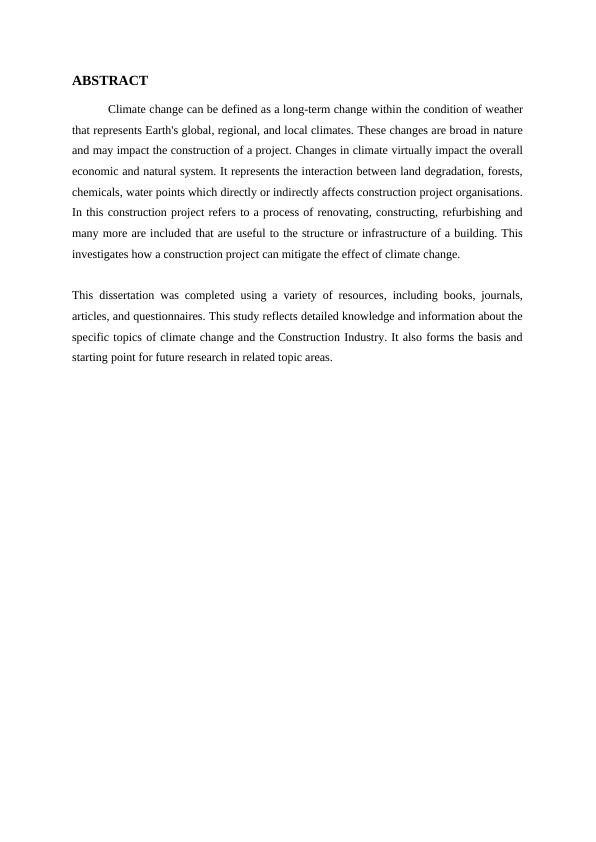
Table of Contents
Research Topic: “Climate emergency: A critical view on how the construction industry can
mitigate the effects of climate change”............................................................................................
Chapter 1: Introduction....................................................................................................................
1.1. Background to the study..................................................................................................1
1.2. Rationale for selection of topic........................................................................................2
1.3. Research aim and objectives...........................................................................................2
1.4. Research questions.........................................................................................................3
1.5. Scope and limitation......................................................................................................3
Chapter 2: Literature Review...........................................................................................................
Impact of climate change on buildings and constructions......................................................4
Ways to reduce the contribution to climate change in the Construction industry..................7
Strategies that the industry can adopt to reduce the costs of going green – make it more
attractive to go green............................................................................................................10
Analysis of the way renewable materials used in construction can help in reducing
the environmental impact of construction.......................................................................13
Chapter 3: Research Methodology.................................................................................................
Chapter 4: Data analysis and interpretation...................................................................................
Data analysis.........................................................................................................................21
Interpretation of collected data.........................................................................................24
Chapter 5: Communication and discussion of research findings...................................................
Chapter 6: Conclusion and Recommendation................................................................................
Conclusion...........................................................................................................................43
Recommendation................................................................................................................45
Chapter 7: Reflection.....................................................................................................................
REFERENCES..............................................................................................................................
APPENDIX....................................................................................................................................
Research Topic: “Climate emergency: A critical view on how the construction industry can
mitigate the effects of climate change”............................................................................................
Chapter 1: Introduction....................................................................................................................
1.1. Background to the study..................................................................................................1
1.2. Rationale for selection of topic........................................................................................2
1.3. Research aim and objectives...........................................................................................2
1.4. Research questions.........................................................................................................3
1.5. Scope and limitation......................................................................................................3
Chapter 2: Literature Review...........................................................................................................
Impact of climate change on buildings and constructions......................................................4
Ways to reduce the contribution to climate change in the Construction industry..................7
Strategies that the industry can adopt to reduce the costs of going green – make it more
attractive to go green............................................................................................................10
Analysis of the way renewable materials used in construction can help in reducing
the environmental impact of construction.......................................................................13
Chapter 3: Research Methodology.................................................................................................
Chapter 4: Data analysis and interpretation...................................................................................
Data analysis.........................................................................................................................21
Interpretation of collected data.........................................................................................24
Chapter 5: Communication and discussion of research findings...................................................
Chapter 6: Conclusion and Recommendation................................................................................
Conclusion...........................................................................................................................43
Recommendation................................................................................................................45
Chapter 7: Reflection.....................................................................................................................
REFERENCES..............................................................................................................................
APPENDIX....................................................................................................................................
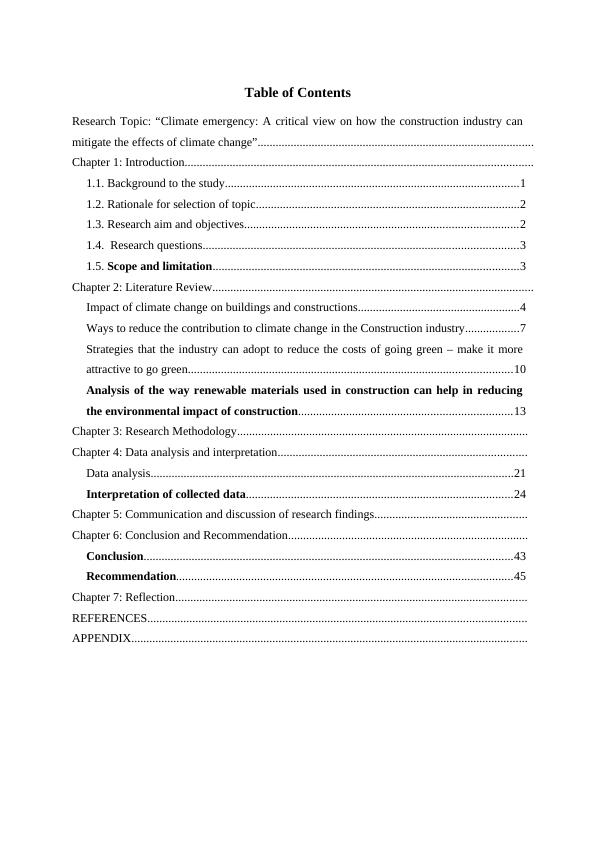

Research Topic: “Climate emergency: A critical view on how the construction
industry can mitigate the effects of climate change”
Chapter 1: Introduction
1.1. Background to the study
Climate change is referred to as a long-term change in an average pattern of weather that
has come to define the global, regional, and local climate of Earth (Ghosh, 2018). These
alterations in climate have a wide range of observed effects which are synonymous with the
term. The change in climate maximizes the risk related to the initiation of the construction
project cycle and can affect the construction sector directly by climate and weather, but can also
impact indirectly like side programming, extra expense, material cost, delivery, labourers’ safety,
delay, etc. In this humans are the major part that will influence climate and overall earth
temperature by cutting down the farming livestock, rainforests, and burning fossil fuels. This
situation requires action aiming to reduce the damage that impacts the environment. Climate
emergencies occur due to human activities such as high usage of fossil fuel, coal, gas, etc. that
result in affecting the climate. These activities may cause pollution in the air and seas and rapid
changes are required for this to be avoided. Due to the changes that occur in the climate several
types of risks are associated with operating a construction project cycle. Changes in climate such
as increased rainfall, rise in temperature directly impact construction projects.
A construction project has a significant influence on the environment all over the world.
Every aspect of the sector has some measurable influence - from mining processes utilised for
materials to the waste developed through the project and the way it is disposed of. There is
sufficient evidence showing that there are significant changes in weather patterns and
temperatures around the world that is posing serious threats to the built environment and other
aspects of our planet. Gunningham, 2019).
To conduct this research, researcher focused on several aspects like literature review,
research methodology, and collecting data by using questionnaires Conclusions are drawn at the
end of the dissertation aiming to enhance the knowledge and skills related to climate change and
their effect on a construction project.
1
industry can mitigate the effects of climate change”
Chapter 1: Introduction
1.1. Background to the study
Climate change is referred to as a long-term change in an average pattern of weather that
has come to define the global, regional, and local climate of Earth (Ghosh, 2018). These
alterations in climate have a wide range of observed effects which are synonymous with the
term. The change in climate maximizes the risk related to the initiation of the construction
project cycle and can affect the construction sector directly by climate and weather, but can also
impact indirectly like side programming, extra expense, material cost, delivery, labourers’ safety,
delay, etc. In this humans are the major part that will influence climate and overall earth
temperature by cutting down the farming livestock, rainforests, and burning fossil fuels. This
situation requires action aiming to reduce the damage that impacts the environment. Climate
emergencies occur due to human activities such as high usage of fossil fuel, coal, gas, etc. that
result in affecting the climate. These activities may cause pollution in the air and seas and rapid
changes are required for this to be avoided. Due to the changes that occur in the climate several
types of risks are associated with operating a construction project cycle. Changes in climate such
as increased rainfall, rise in temperature directly impact construction projects.
A construction project has a significant influence on the environment all over the world.
Every aspect of the sector has some measurable influence - from mining processes utilised for
materials to the waste developed through the project and the way it is disposed of. There is
sufficient evidence showing that there are significant changes in weather patterns and
temperatures around the world that is posing serious threats to the built environment and other
aspects of our planet. Gunningham, 2019).
To conduct this research, researcher focused on several aspects like literature review,
research methodology, and collecting data by using questionnaires Conclusions are drawn at the
end of the dissertation aiming to enhance the knowledge and skills related to climate change and
their effect on a construction project.
1
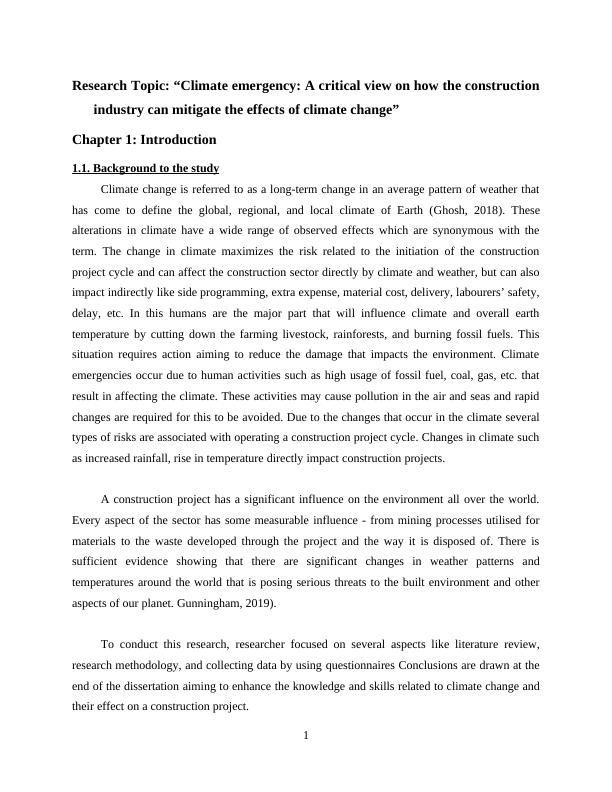
1.2. Rationale for selection of topic
The rationale of research refers to reflecting a reason to conduct particular research. This
study will critically investigate and analyse how the construction industry can mitigate the
effects of climate change and will assist in providing deep insights and knowledge on the topic.
This makes the researcher able to study the overview of the construction of buildings and
infrastructure and investigate different ways the Construction Industry can minimise and mitigate
Climate Change (Tong and Ebi, 2019). Additionally, strategies for decreasing the costs of going
green in the Construction Industry will be investigated. Moreover, this project also determines
different construction methods, services, and materials that will reduce the impact of buildings
on the environment. Through this investigation, it will be possible to perform further studies on
the topic effectively and systematically. This study will also assess the way in which renewable
materials are utilized in construction and how these can assist in reducing the negative impact of
construction on the environment. and thus provide a deeper understanding of the links between
climate change and the construction industry.
1.3. Research aims and objectives
Research aim
Research aim refers to the intention of conducting particular research by summarising in
a sentence. It helps the researcher to conduct research effectively and on time. The research aim
is to be written in wide terms and shows what was achieved at the end of the dissertations. The
main aim of the current investigation is “To critically investigate and analyse how the
construction industry can mitigate the effects of climate change”.
Research objectives
Objectives of research are defined as the purpose of conducting particular research. It
helps the researcher to attain their targets effectively and efficiently. These objectives are the
essential part of conducting research and attaining the aim of the study that offers a pathway to
investigators related to perform a task in a systematic manner (Salimi and Al-Ghamdi, 2020).
The main objectives which are reviewed and analysed through the current investigation are listed
below:
To study the impact of climate change on buildings and structures
2
The rationale of research refers to reflecting a reason to conduct particular research. This
study will critically investigate and analyse how the construction industry can mitigate the
effects of climate change and will assist in providing deep insights and knowledge on the topic.
This makes the researcher able to study the overview of the construction of buildings and
infrastructure and investigate different ways the Construction Industry can minimise and mitigate
Climate Change (Tong and Ebi, 2019). Additionally, strategies for decreasing the costs of going
green in the Construction Industry will be investigated. Moreover, this project also determines
different construction methods, services, and materials that will reduce the impact of buildings
on the environment. Through this investigation, it will be possible to perform further studies on
the topic effectively and systematically. This study will also assess the way in which renewable
materials are utilized in construction and how these can assist in reducing the negative impact of
construction on the environment. and thus provide a deeper understanding of the links between
climate change and the construction industry.
1.3. Research aims and objectives
Research aim
Research aim refers to the intention of conducting particular research by summarising in
a sentence. It helps the researcher to conduct research effectively and on time. The research aim
is to be written in wide terms and shows what was achieved at the end of the dissertations. The
main aim of the current investigation is “To critically investigate and analyse how the
construction industry can mitigate the effects of climate change”.
Research objectives
Objectives of research are defined as the purpose of conducting particular research. It
helps the researcher to attain their targets effectively and efficiently. These objectives are the
essential part of conducting research and attaining the aim of the study that offers a pathway to
investigators related to perform a task in a systematic manner (Salimi and Al-Ghamdi, 2020).
The main objectives which are reviewed and analysed through the current investigation are listed
below:
To study the impact of climate change on buildings and structures
2
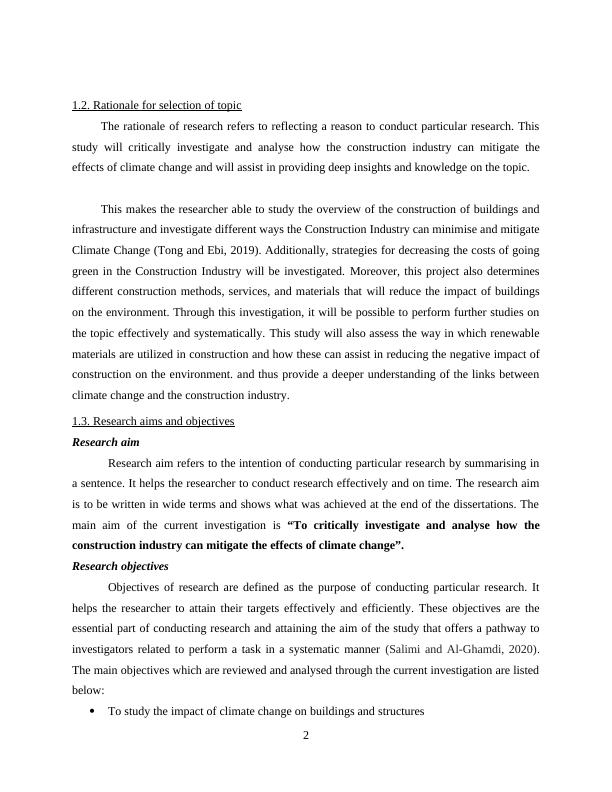
To assess the ways to reduce the Construction Industry’s contribution to climate change.
To identify the strategies that the industry can adopt to reduce the costs of going green –
making this option more attractive.
To assess the way renewable materials are used in construction and how these can help in
reducing the environmental impact of construction.
1.4. Research questions
Research question defines those questions that are set by an investigator on a specific project
to present an answer. It is a very crucial element for conducting the whole research proficiently.
For conducting this particular research several questions are to be reflected below as per the aim
of the project.
How may climate change influence buildings and construction?
How can we reduce the contribution to climate change in the Construction industry?
What can the industry do to reduce the costs of going green – making this option more
attractive?
How the environmental impact of construction can be reduced by using renewable
materials?
1.5. Scope and limitation
The scope of the project is wider as it provides various advantages to the organisations
operating in the construction sector. It also helps in gaining the knowledge about climate change
that affects the construction project. It is highly useful in future professional careers. The
findings from this work will be able to be used in the future by construction professionals to
minimise the effect of the construction industry on climate change. At the time of conducting this
research, several activities are to be included in which the investigator faces several issues and
limitations. These limitations may impact negatively on the end results of the whole dissertation.
All these issues impact negatively on research activities (Yigitcanlar and et. al., 2019). At this
time the researcher plays an important role in managing all these limitations by using ethical
practices and preparing a Gantt chart, work break down structure, etc. so that time would be
managed to do several activities in the entire research. In this investigator also support and
listens to respondent views related to a particular topic so that reliable and viable outcomes are
presented at the end of the research.
3
To identify the strategies that the industry can adopt to reduce the costs of going green –
making this option more attractive.
To assess the way renewable materials are used in construction and how these can help in
reducing the environmental impact of construction.
1.4. Research questions
Research question defines those questions that are set by an investigator on a specific project
to present an answer. It is a very crucial element for conducting the whole research proficiently.
For conducting this particular research several questions are to be reflected below as per the aim
of the project.
How may climate change influence buildings and construction?
How can we reduce the contribution to climate change in the Construction industry?
What can the industry do to reduce the costs of going green – making this option more
attractive?
How the environmental impact of construction can be reduced by using renewable
materials?
1.5. Scope and limitation
The scope of the project is wider as it provides various advantages to the organisations
operating in the construction sector. It also helps in gaining the knowledge about climate change
that affects the construction project. It is highly useful in future professional careers. The
findings from this work will be able to be used in the future by construction professionals to
minimise the effect of the construction industry on climate change. At the time of conducting this
research, several activities are to be included in which the investigator faces several issues and
limitations. These limitations may impact negatively on the end results of the whole dissertation.
All these issues impact negatively on research activities (Yigitcanlar and et. al., 2019). At this
time the researcher plays an important role in managing all these limitations by using ethical
practices and preparing a Gantt chart, work break down structure, etc. so that time would be
managed to do several activities in the entire research. In this investigator also support and
listens to respondent views related to a particular topic so that reliable and viable outcomes are
presented at the end of the research.
3
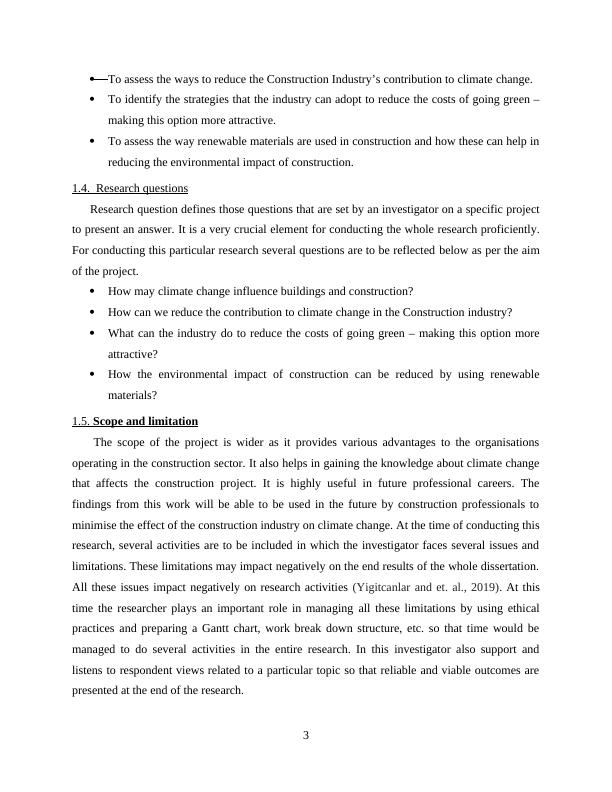
Significance of research- It refers to a written statement that is useful to present the
benefits of conducting a particular study. It elaborates the justification of implementing this
study and its impact on the research field. It also reflects a contribution to new knowledge and in
what manner it is beneficial for others. To conduct this particular research on a specific topic that
is ‘how the construction industry can mitigate the effect of climate change’ helps in gaining
knowledge related to climate and weather change and how it impacts on the construction
industry. This also helps in presenting the strategies related to mitigating the risk of climate
change that is beneficial for all construction companies.
Chapter 2: Literature Review
1. Impact of climate change on buildings and constructions
As presented by Ahmed, (2020), Climate is a complex phenomenon which is continuously
affected through the amount of radiation emitted by the sun reflected back to space, the amount
reaches to ground, and the amount stays in the atmosphere. A prominent role is played by these
climatic agents in the deterioration of the building fabric. Any change in climatic conditions is
expected to have a critical effect on the deterioration rate. When the greenhouse gases increase
the temperature on our planet, this causes ice and snow to melt. This leads to less sunlight that is
being reflected back to space, thus warming up the atmosphere (Crate and Nuttall, 2016). Fossil
fuels like natural gas, petroleum, and coal originate from dead vegetation, which over millions of
years, become fossilised containing a high percentage of carbon. In order to warm houses, power
factories, and move vehicles, fossil fuels are burnt. By doing so carbon dioxide as well as other
gases, which have been known to have an influence on global warming, are released into the
atmosphere (Tol, 2018)
As mentioned by Skullestad, Bohne, and Lohne, (2016), Construction and buildings are
responsible for around 39 % of carbon emissions all over the world, out of this 11 percent from
manufacturing construction materials and 28% from energy consumption, also called embodied
carbon. The energy consumption of buildings comes from its requirement to warm up as well as
cool down the structure when a building has not been developed to be efficient in terms of
ventilation and insulation. The embodied carbon of building comes from manufacturing as well
as supplying of construction materials and products along with the construction process itself.
4
benefits of conducting a particular study. It elaborates the justification of implementing this
study and its impact on the research field. It also reflects a contribution to new knowledge and in
what manner it is beneficial for others. To conduct this particular research on a specific topic that
is ‘how the construction industry can mitigate the effect of climate change’ helps in gaining
knowledge related to climate and weather change and how it impacts on the construction
industry. This also helps in presenting the strategies related to mitigating the risk of climate
change that is beneficial for all construction companies.
Chapter 2: Literature Review
1. Impact of climate change on buildings and constructions
As presented by Ahmed, (2020), Climate is a complex phenomenon which is continuously
affected through the amount of radiation emitted by the sun reflected back to space, the amount
reaches to ground, and the amount stays in the atmosphere. A prominent role is played by these
climatic agents in the deterioration of the building fabric. Any change in climatic conditions is
expected to have a critical effect on the deterioration rate. When the greenhouse gases increase
the temperature on our planet, this causes ice and snow to melt. This leads to less sunlight that is
being reflected back to space, thus warming up the atmosphere (Crate and Nuttall, 2016). Fossil
fuels like natural gas, petroleum, and coal originate from dead vegetation, which over millions of
years, become fossilised containing a high percentage of carbon. In order to warm houses, power
factories, and move vehicles, fossil fuels are burnt. By doing so carbon dioxide as well as other
gases, which have been known to have an influence on global warming, are released into the
atmosphere (Tol, 2018)
As mentioned by Skullestad, Bohne, and Lohne, (2016), Construction and buildings are
responsible for around 39 % of carbon emissions all over the world, out of this 11 percent from
manufacturing construction materials and 28% from energy consumption, also called embodied
carbon. The energy consumption of buildings comes from its requirement to warm up as well as
cool down the structure when a building has not been developed to be efficient in terms of
ventilation and insulation. The embodied carbon of building comes from manufacturing as well
as supplying of construction materials and products along with the construction process itself.
4
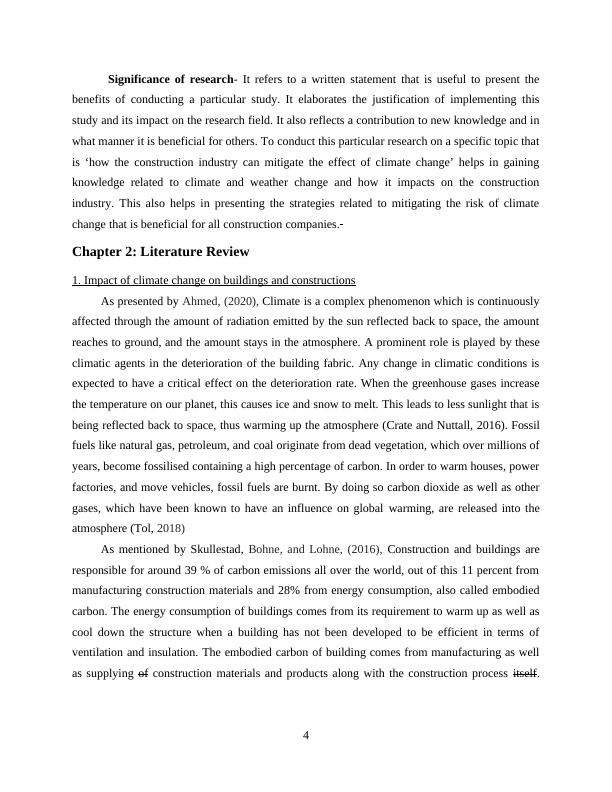
End of preview
Want to access all the pages? Upload your documents or become a member.
Related Documents
Mitigating the Effects of Climate Change in the Construction Industrylg...
|52
|18065
|1
SREM01-8 Abstract The Effects of the Emission of Greenhouse Gas on the Earth's Atmospherelg...
|11
|2867
|441
To what extent is Climate Change a result of human activities?lg...
|6
|1421
|63
BUS2SUS - Sustainability and Environmental Studies - Essaylg...
|7
|1947
|85
Climate Change and the Role of International Agreementslg...
|8
|1342
|333
AI System to Monitor Weather and Climate Change Assignment 2022lg...
|9
|3693
|15
